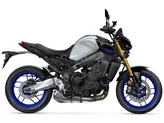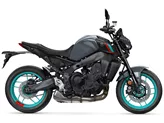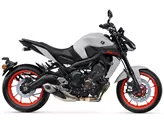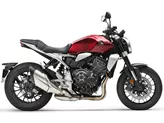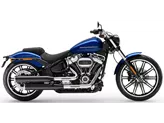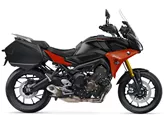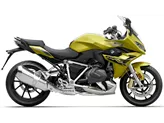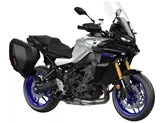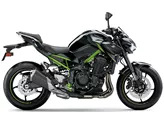Kawasaki Z 800 2013 vs. Yamaha MT-09 2016

Kawasaki Z 800 2013

Yamaha MT-09 2016
Overview - Kawasaki Z 800 2013 vs Yamaha MT-09 2016
In terms of engine and drive train, both the Kawasaki Z 800 2013 and the Yamaha MT-09 2016 have an inline engine type. However, the Yamaha MT-09 has a slightly higher engine power of 115 HP compared to the Kawasaki Z 800's 113 HP. The torque is also higher in the Yamaha MT-09 with 87.5 Nm compared to the Kawasaki Z 800's 83 Nm. The Yamaha MT-09 has three cylinders while the Kawasaki Z 800 has four. The displacement is also higher in the Yamaha MT-09 with 847 ccm compared to the Kawasaki Z 800's 806 ccm.
In terms of suspension, the Kawasaki Z 800 2013 has an upside-down telescopic fork for the front suspension, while the Yamaha MT-09 2016 has a telescopic fork.
In terms of chassis, the Kawasaki Z 800 2013 has a steel frame, while the Yamaha MT-09 2016 has an aluminum frame. The frame type of the Kawasaki Z 800 is a double cradle, while the Yamaha MT-09 has a twin tube frame type.

Kawasaki Z 800 2013
Both bikes have double disk brakes at the front. The front tire width and diameter are the same for both bikes, with a width of 120 mm and a diameter of 17 inches. The rear tire width and diameter are also the same for both bikes, with a width of 180 mm and a diameter of 17 inches.
The wheelbase of the Kawasaki Z 800 2013 is slightly longer at 1445 mm compared to the Yamaha MT-09 2016's 1440 mm. The seat height of the Kawasaki Z 800 is higher at 834 mm compared to the Yamaha MT-09's 815 mm. The kerb weight of the Kawasaki Z 800 is heavier at 229 kg compared to the Yamaha MT-09's 188 kg. The fuel tank capacity of the Kawasaki Z 800 is larger at 17 liters compared to the Yamaha MT-09's 14 liters.
In terms of strengths, the Kawasaki Z 800 2013 has an eye-catching, chunky look. It also has confident acceleration and a relaxed geometry, making it comfortable for long rides. The powerful brakes of the Kawasaki Z 800 provide excellent stopping power.

Yamaha MT-09 2016
On the other hand, the Yamaha MT-09 2016 has a wonderfully powerful three-cylinder powerplant. It also has three power modes, allowing the rider to adjust the performance according to their preference. The fully adjustable chassis of the Yamaha MT-09 provides a customizable riding experience. The quickshifter as standard is a convenient feature, and the sporty upright seating position adds to the bike's agility. The Yamaha MT-09 also has good brakes and aggressive looks, making it visually appealing. The inclusion of traction control enhances safety.
In terms of weaknesses, the Kawasaki Z 800 2013 has limited freedom of movement for the legs, which may affect rider comfort on long rides.
On the other hand, the Yamaha MT-09 2016 has a saddle that is a little too hard for long tours, which may cause discomfort during extended rides. Additionally, the license plate holder on the swingarm offers less splash protection than a conventional one, which may result in more dirt and water splashing onto the rider and the bike.
Technical Specifications Kawasaki Z 800 2013 compared to Yamaha MT-09 2016
Pros and Cons in comparison
Pros and Cons in comparison
Kawasaki Z 800 2013

Overall, the Z800 delivered a sensational performance. Considering the fact that nothing was changed or optimised on the vehicle apart from the Remus rear silencer, a super final result.
Yamaha MT-09 2016

The Yamaha MT-09 did not need to be reinvented for the coming season - it already was extremely well done almost four years ago. Instead, the Japanese focus on fine-tuning and adding practical, contemporary gimmicks such as traction control and automatic shifting. Due to the Euro4 standard, however, the engine management has been changed once again and offers an emphatically powerful but well controllable power delivery in standard mode; the power explosion of the first generation is now no longer offered even by the sharper A mode. The biggest change, recognisable at first glance, is the, in my opinion, extremely successful design with the more aggressive front and the newly designed rear. All in all, an even snazzier naked bike that was clearly built for the fun of motorcycling.
Price Comparison Avarage Market Price Kawasaki Z 800 vs Yamaha MT-09
There are a few key differences between a Kawasaki Z 800 2013 and a Yamaha MT-09 2016. In terms of price, the actual average price of a Yamaha MT-09 2016 is about 15% higher. Compared to Yamaha MT-09 2016 there are less Kawasaki Z 800 2013 bikes available on the 1000PS.de Marketplace, specifically 7 compared to 11. It takes less time to sell a Kawasaki Z 800 with 56 days compared to 87 days for a Yamaha MT-09. Since model year 2013 1000PS.de editors have written 11 reviews for the Kawasaki Z 800 and 57 reviews for the Yamaha MT-09 since model year 2013. The first review for the Kawasaki Z 800 was published on 9/6/2012 and now has more than 8,100 views. This compares to more than 39,900 views for the first review on Yamaha MT-09 published on 6/10/2013.


